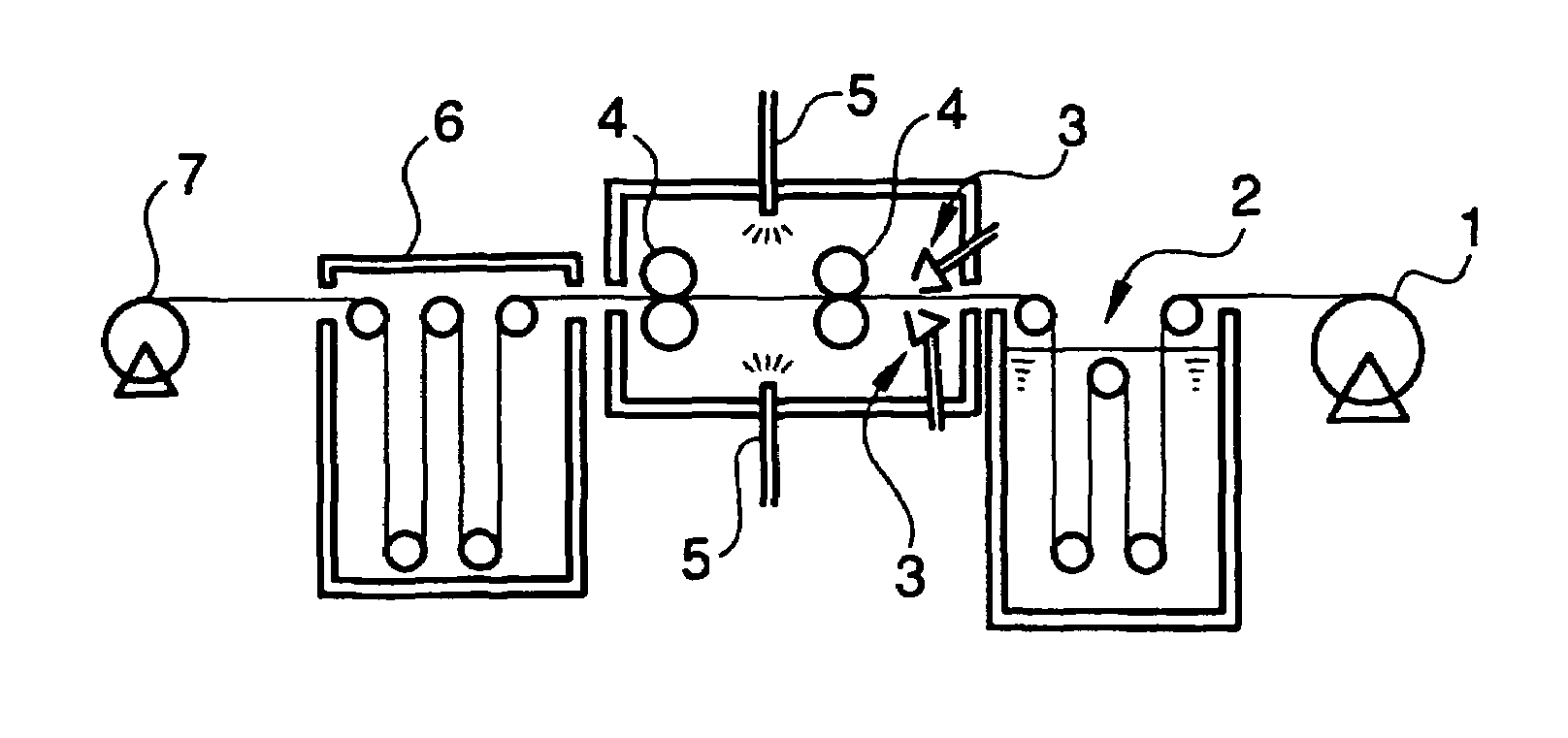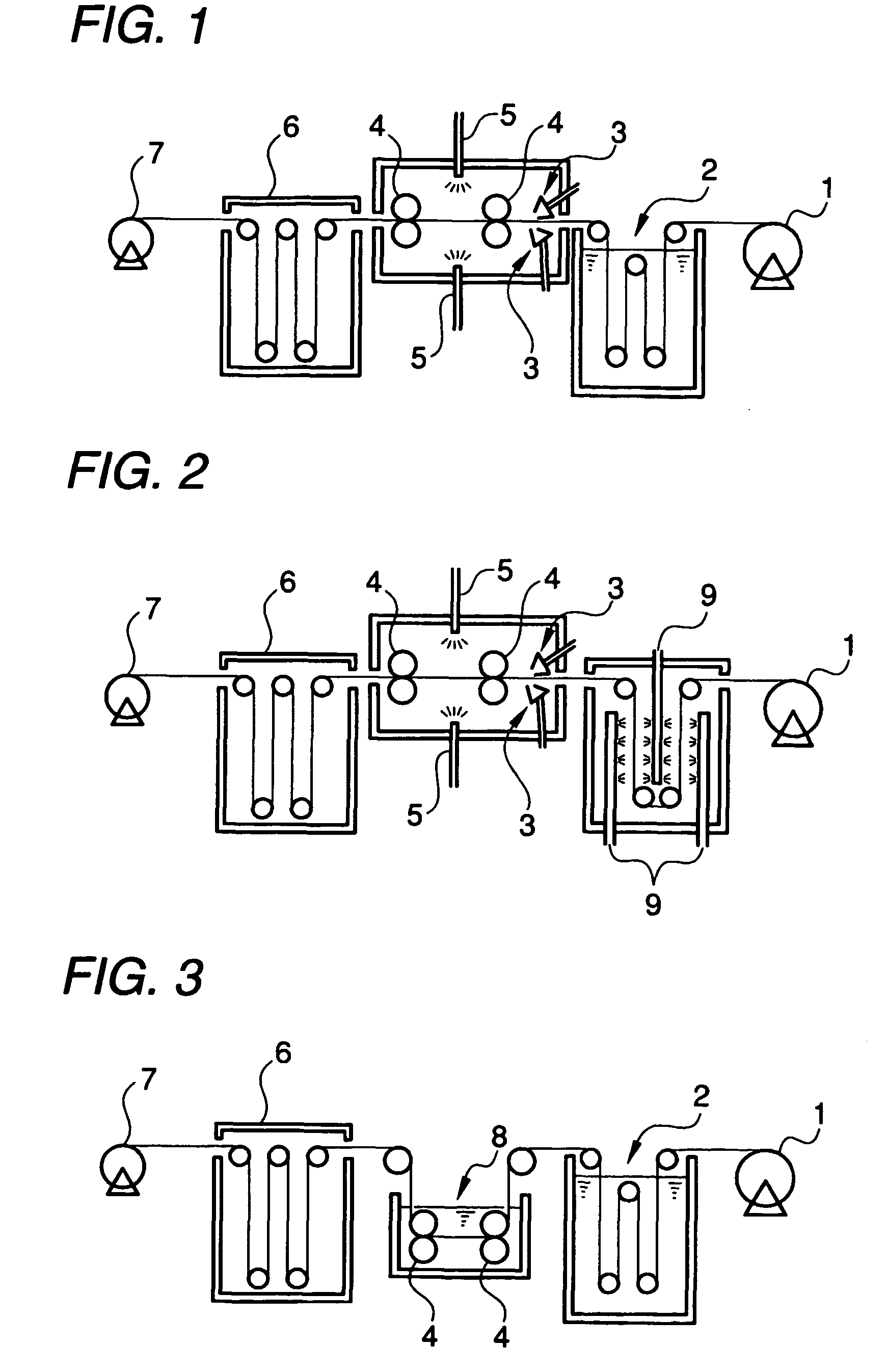Method for producing optical compensating film, optical compensating film, circularly polarizing plate, and liquid crystal display
a technology of optical compensating film and liquid crystal display, which is applied in the direction of polarizing elements, lighting and heating apparatuses, instruments, etc., can solve the problem of high cost and achieve the effect of good view angle characteristics
- Summary
- Abstract
- Description
- Claims
- Application Information
AI Technical Summary
Benefits of technology
Problems solved by technology
Method used
Image
Examples
example 1
(Formation of Optical Compensating Film 1)
[0330]The cellulose acetate film 1 formed in the above was dipped in a water thermostat at 80° C. for 5 minutes. Thus dipped, the film absorbed water to have a water content of 4.63% by weight. Then, this was put into an air thermostat at 90° C., and then immediately stretched by 42.5%. This was stretched in a clip-to-clip stretching method, in which the aspect ratio (L / W) was 0.8 and the stretching time was 9 seconds. Immediately after stretched, the water content of the film was 4.7% by weight. Next, this was dried in a thermostat at 80° C. for 3 minutes, and then conditioned at 25° C. and 60% RH for at least 2 hours. The optical properties of the film were measured, and the data obtained are given in Table 1. After stretched, the thickness of the film was 115 μm.
example 2
(Formation of Optical Compensating Film 2)
[0331]The cellulose acetate film 1 formed in the above was dipped in a water thermostat at 80° C. for 5 minutes. Thus dipped, the film absorbed water to have a water content of 4.63% by weight. Then, this was put into a high-humidity thermostat at 70° C. and 95% RH, and then immediately stretched by 35%. This was stretched in a clip-to-clip stretching method, in which the stretch aspect ratio (L / W) was 0.8 and the stretching time was 7 seconds. Immediately after stretched, the water content of the film was 4.8% by weight. After taken out, the film was dried in a thermostat at 80° C. for 3 minutes, and then conditioned at 25° C. and 60% RH for at least 2 hours. The optical properties of the film were measured, and the data obtained are given in Table 1. After stretched, the thickness of the film was 117 μm.
example 3
(Formation of Optical Compensating Film 3)
[0332]The cellulose acetate film 1 formed in the above was dipped in a water thermostat at 80° C. for 5 minutes. Thus dipped, the film absorbed water to have a water content of 4.63% by weight. Then, this was put into a high-humidity thermostat at 70° C. and 95% RH, and then immediately stretched by 42.5%. This was stretched in a clip-to-clip stretching method, in which the stretch aspect ratio (L / W) was 1.0 and the stretching time was 9 seconds. Immediately after stretched, the water content of the film was 4.8% by weight. After taken out, the film was dried in a thermostat at 80° C. for 3 minutes, and then conditioned at 25° C. and 60% RH for at least 2 hours. The optical properties of the film were measured, and the data obtained are given in Table 1. After stretched, the thickness of the film was 115 μm.
PUM
| Property | Measurement | Unit |
|---|---|---|
| wavelength | aaaaa | aaaaa |
| wavelength | aaaaa | aaaaa |
| wavelength | aaaaa | aaaaa |
Abstract
Description
Claims
Application Information
 Login to View More
Login to View More - R&D Engineer
- R&D Manager
- IP Professional
- Industry Leading Data Capabilities
- Powerful AI technology
- Patent DNA Extraction
Browse by: Latest US Patents, China's latest patents, Technical Efficacy Thesaurus, Application Domain, Technology Topic, Popular Technical Reports.
© 2024 PatSnap. All rights reserved.Legal|Privacy policy|Modern Slavery Act Transparency Statement|Sitemap|About US| Contact US: help@patsnap.com










